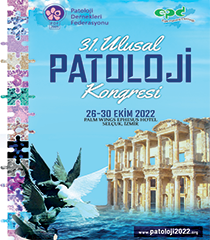Güncel Patoloji Dergisi
2018 , Vol 2 , Num 2
Ovarian endometrioid stromal sarcoma in frozen section; case report
1 Kocaeli University Medical Faculty Pathology Department
Özet
Introduction:Endometrioid Stromal Sarcoma (ESS) is an uncommon tumor that occurs in women over wide age range and accounting for only 0.2% of all uterine malignancies and for 15%-26% of primary uterine sarcomas. We herein present a rare case of ESS, which was misdiagnosed as a stromal tumor, probably a granulosa cell tumor on intraoperative frozen section examination of the ovarian mass.
Case report:
A huge ovarian mass (25 cm) of 27-year-old female patient was sent to intraoperative consultation with limited clinical information. The lesion had nodular solid areas with tan-yellow cut surface. On microscopic examination, the predominant pattern was striking nodular growth of small cells with interspersed arterioles. Nodular areas of foam cells were present extensively. Postoperative paraffin sections of the ovary and uterus revealed synchronous neoplasms of similar histomorphology and positive immunoreactivity with CD10. Additonally, lymphovascular invasion was detected. The tumor was not associated with endometriosis of the ovary. Detailed clinical history of the patient revealed myomectomy (?) in a different hospital five years and Cesarean section and myomectomy (?) four years ago. Retrospective evaluation of the previous excisions was consistent with low-grade ESSs.
Conclusion:
The present case indicates a wide morphological spectrum of ESS. The distinction between uterine smooth muscle tumors such as cellular leiomyoma and myxoid leiomyosarcoma and low-grade ESS (LG-ESS) can be problematic. When a primary ovarian origin is considered, the differential diagnosis is most often with a sex cord-stromal tumor, particularly a granulosa cell tumor because of a diffuse growth of cells with scant cytoplasm. The differential diagnosis of these neoplasms is in the first instance with a metastasis from the uterus; knowledge of the status of the uterus is paramount in this distinction. In LG-ESS, ovarian preservation and mitotoc activity index >3 are associated with increased risk of recurrence.


